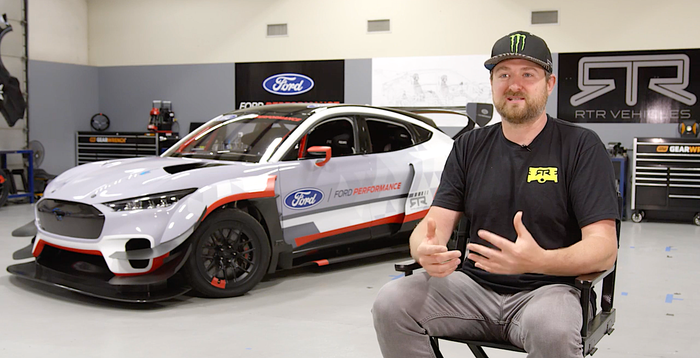Ford Mustang Mach-E Smokes EV Performance Perceptions
Seven electric motors and a high-performance battery pack provide the Mustang Mach-E 1400 performance to burn.

Mustang Mach-E 1400 prototypeFord Motor Co.
Ford’s decision to introduce a battery electric crossover SUV wearing a “Mustang” badge stirred more than a little controversy and push back from traditionalists. The company aims to calm their concerns by underscoring the performance potential of such vehicles with an incredible new 1,400-horsepower, 160 mph, seven-motor, all-wheel drive prototype it dubs the Mustang Mach-E 1400.
Ford leaned on pro drift driver Vaughn Gittin Jr. and his RTR Vehicles fabrication shop to turn a bare Mach-E body-in-white into the fearsome, tire-smoking Mach-E 1400.
In contrast to the Mustang Cobra Jet 1400, which is a drag race-specific machine, the Mach-E 1400 features the suspension and aerodynamic revisions necessary for solid performance on road racing tracks and circuitous gymkhana courses in addition to straight line drag strips.
“Now is the perfect time to leverage electric technology, learn from it, and apply it to our lineup,” said Ron Heiser, chief program engineer, Mustang Mach-E. “Mustang Mach-E is going to be fun to drive, just like every other Mustang before it, but Mustang Mach-E 1400 is completely insane, thanks to the efforts of Ford Performance and RTR.”
Author Malcolm Gladwell asserts in his book, “Outliers,” that people achieve extraordinary skills after 10,000 hours of practice, so we should have high expectations for the Mustang Mach-E 1400. Ford says that Ford Performance engineers and RTR’s craftsmen pour 10,000 hours of sweat into creating this electric beast.
Gittin says he’s a believer in electric power now. “Getting behind the wheel of this car has completely changed my perspective on what power and torque can be,” said Gittin. “This experience is like nothing you’ve ever imagined, except for maybe a magnetic roller coaster.”

Because the Mach-E 1400 was built for demonstration purposes and not to the rules requirements of any racing series, engineers had a free hand in creating its hardware and aerodynamics. The left them free to optimize its aerodynamics for shape and location, with a focus on cooling ducts, front splitter, dive planes and rear wing.
The immense power of the seven electric motors (three in the front and four driving the rear axle) posed another challenge. Power flows through adjustable differentials, which makes it possible to tailor the Mach-E’s power delivery for the course it is on at the time.
“The challenge was controlling the extreme levels of power provided by the seven motors,” said Mark Rushbrook, motorsports director, Ford Performance. “Mustang Mach-E 1400 is a showcase of the art of the possible with an electric vehicle.”
Ford notes that drift and track setups have completely different front-end configurations like control arms and steering changes to allow for extreme steering angles in drifting. Power delivery can be split evenly between front and rear, or completely to one or the other.
In consideration of the Mach E 1400’s mission and the resulting high discharge rate required of its batteries, the car uses a 56.8-kilowatt-hour nickel manganese cobalt pouch cell battery pack for ultra-high performance
Cooling the cells is also critical, so the system uses a di-electric coolant that reduces the recovery time needed between runs.
The car also needs to stop and to use its rear brakes to initiate drifts, so Ford installed high-performance Brembo racing brakes with an electric brake booster.
Mach-E 1400 will tear up tracks before Nascar races this season, providing a demonstration of the performance potential of electric vehicles like the Mustang before fans who are likely to be true combustion die hards.
About the Author(s)
You May Also Like





